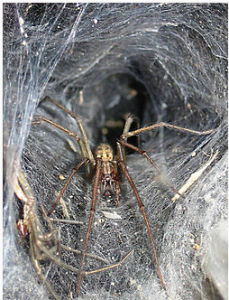 Like the hobo house spider, the giant house spider is a native of Europe that has found its way to the United States through human activity. It is active in the Pacific Northwest.
Like the hobo house spider, the giant house spider is a native of Europe that has found its way to the United States through human activity. It is active in the Pacific Northwest.
The spider is named as such because of its incredibly long legs. Females can have leg spans of approximately 45 millimeters in addition to its 18-millimeter body size. Males on the other hand can have longer legs of up to 75 millimeters, and body sizes of 12-15 millimeters.
The giant house spider also builds funnel-shaped webs most often in a corner or in between objects not frequented by large animals or humans. It squeezes itself into the narrow end of the funnel and waits for a victim to pass by before it pounces on it. Not many are known to escape, of course; the giant house spider previously carried the Guinness World Record for top spider speed at 9.73 feet per second until it was surpassed by sun spiders in 1987.
Its relationship with its fellow house spider, the hobo, is interesting. Experts are of the opinion that the giant house spider can prevent the hobo house spider from living and developing nests inside a house. The hobo is said to be a very dangerous spider for humans (although this has not been proven and is hotly debated) thus it could be said that the appearance of a giant house spider may be beneficial to humans.
Indeed, spiders are generally helpful to a human home because of their diet of eating insects like flies and moths. The threat of a spider bite, regardless of the species, is something that should not be ignored although only a few types of spiders can actually be harmful like the Brown Recluse Spider.
To prevent the Giant House Spider from developing a population inside your home, make sure to seal all cracks and crevices that lead to your interiors. You must also keep the doors closed when it is not necessary to be opened so a wandering female may not find its way in.
In the event that you see a spider web, you can make use of non-chemical treatment methods like a vacuum or a broom. This will remove the nest, the spider and the eggs that it is taking care of without getting into contact with the arachnid itself.
Insecticides are generally not effective against spiders except for a direct shot. However, well placed residual pesticides such as dusts or wettable powders can yield some positive results. If you’re at all concerned about this or any spider problem in your home it may be best to call in a pro.




